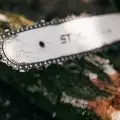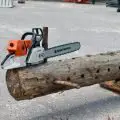You might want to take into account a shorter-size bar and a shorter chain when it comes time to buy a replacement bar for your chainsaw model. Several variables will determine whether this improves cutting or increases engine power.
In this article, we will assist you in determining if it is preferable for you to put a shorter bar on your chainsaw, along with the potential benefits and drawbacks.
Table of Contents
- Can A Chainsaw Bar Be Replaced With A Shorter Blade?
- What Are the Benefits of Putting a Shorter Bar on a Chainsaw?
- What Are the Drawbacks of Putting a Shorter Bar on a Chainsaw?
- How to Put a Shorter Bar on Your Chainsaw
- FAQs (Frequently Asked Questions)

Can A Chainsaw Bar Be Replaced With A Shorter Blade?
You can change the guide bar lengths to make your machine better at the particular tasks you need it for. Since the chainsaw’s engine can run securely and its features are made to protect the operator from a blade of that size, the largest blade is typically sold with the chainsaw.
Typically, you may find a bar that is one or two sizes smaller than the conventional size and be able to replace it; however, you must ensure that the bar is the same type as your current blade, or you risk having to replace more components.
The surface area of the chain decreases when the bar size is decreased. By doing this, the saw’s engine or motor is subjected to less strain from the chain’s inertial mass, cut surface size, and bar drag.
By lowering the inertial mass and the number of cutting links enmeshed in the wood, a skip chain can also lessen the drag on the engine. Both make your saw more lively and, in my experience, speed up cutting.
The majority of consumer chainsaws highlight the bar size in their marketing. Typically, they are offered for sale with a bar length that is close to their capacity. Reducing the bar length brings the saw closer to its optimal operating range.
Key Considerations for Changing to a Shorter Chainsaw Chain
In order for the machine to function to its maximum potential when a chainsaw bar is replaced, the drive links, drive sprocket, chain size, chain gauge, and chain groove must all match up properly.
The driving chain or links must maintain sufficient tension or they would slip, making it impossible for the blade to properly cut through wood. To make sure that your chainsaw and all of its components work together flawlessly, each component can be altered or changed.
To tighten correctly and prevent slipping or snagging while in operation, the chain size and pitch must be precise when replacing a chain. To further boost chain speed and decrease the friction of the chain on wood, chain segments can be deleted and a safety chain added.
In order to obtain optimum lubrication, the guide bar and chainsaw chains must fit tightly on the metal bar posts and line up with the oil nipple. Otherwise, issues could develop during prolonged operations.
Visit our guide on How to Put a Chain On a Chainsaw Correctly – GUIDE!
What Are the Benefits of Putting a Shorter Bar on a Chainsaw?
Short bars enable your engine to run for extended periods of time without overheating or snagging because they often have the fastest torque and the least friction.
The shorter bars significantly lower the weight of a chainsaw and can delay the onset of tiredness. A shorter blade can cut through thinner materials in a lot less time than it would take a longer blade to handle smaller logs.
What Are the Drawbacks of Putting a Shorter Bar on a Chainsaw?
Shorter blades may need chain and sprocket adjustments, as most store models are fitted with the parts to run larger blades. It can be difficult to find stock of high-quality, branded short guide bars as most available are subpar-quality Chinese parts. The reduced nose radius of a shorter blade can increase the effort needed and blunt chains when cutting larger and harder wood.
How to Put a Shorter Bar on Your Chainsaw
Proper maintenance of a chainsaw involves regularly changing the chainsaw bar, which also allows for the saw to be used for different tasks. The versatility of a chainsaw increases with the ability to switch between different blade sizes.
However, it is crucial to follow the proper procedures and take the necessary precautions when changing the blade to avoid causing damage to internal components or posing a risk to the operator’s safety. The following steps can guide you through the process of changing the blade:
Remove Old Bar
To change the guide bar on a chainsaw, first, remove the side panel and the fasteners that secure the bar in place. Make sure everything is loose, and then remove any other components that hold the bar in place.
Clean the area from any debris, wood debris, lubrication build-up, and chain shavings that might have accumulated, and hold the guide bar in place. Once all the debris is removed, take the blade out of the sprocket, and clean any debris around the sprocket, drive links, and metal pins before reassembling the other parts.
Change the Sprocket
You will also need to replace the existing sprocket if the chainsaw guide bar you are installing is smaller than it can support. A smaller sprocket is required to support a smaller blade since it can operate in tighter spaces and through better gaps. Replace the stock drive sprocket with one that is the proper size for the new blade by adhering to the manufacturer’s instructions.
Change the Guide Bar
Verify the gauge and pitch figures and make sure they match the chain and sprocket you intend to use. To secure the bar in place, align it with the screws and slip one end of it between the metal posts.
Pull the bar as far forward as the fastener will allow while holding it by the nose, and then firmly tighten the nuts. Make sure there is no friction on internal components and that all the parts fit snugly together.
Alternatively, you may opt to put a longer chainsaw bar on your chainsaw, if you’re considering this, visit our Can I Put a Longer Bar on My Chainsaw? Benefits & How to Guide!
FAQs (Frequently Asked Questions)
Can you shorten a chainsaw bar?
Up to three different bar sizes can often be used with chainsaws. The size of guide bars ranges from 14 to more than 40 inches, measured from the tip of the bar to the heel. To find out what size bars your saw can handle, check the specs in the operator’s manual for your model.
Can I put a 16-inch bar on a 18-inch chainsaw?
Yes, but you also require a bar that is made to fit your saw. The bar must fit the chain/sprocket arrangement, and different saws have different designs. If you wish to do that, your best option is to take it to a dealer to ensure that everything lines up.





